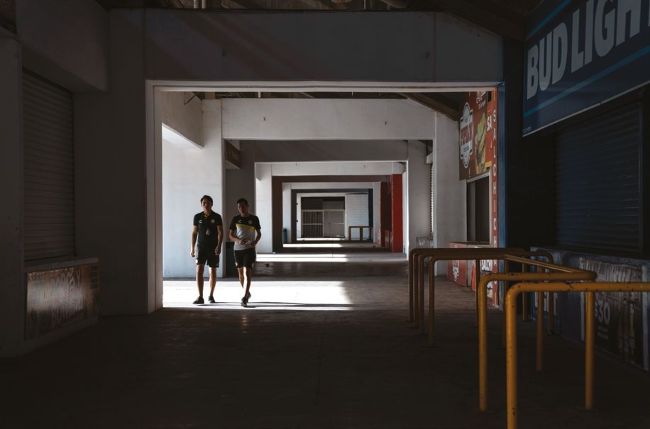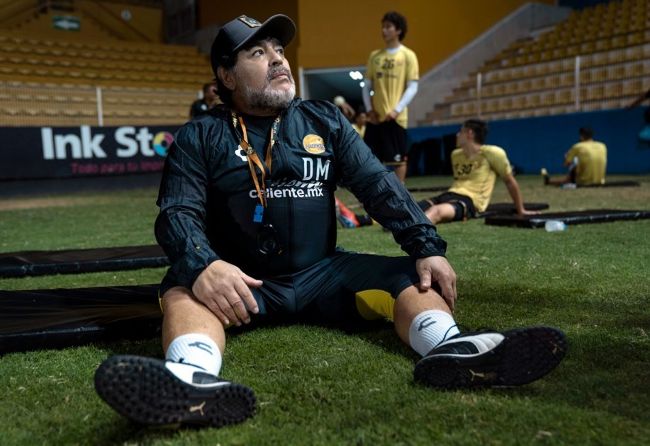FINDING DIEGO
A little over a year before his untimely death at the age of 60, Diego Maradona was managing Mexican second-tier side Dorados de Sinaloa – FourFourTwo went deep into drug cartel country to track him down
Words Andy Mitten

Estadio Banorte
“GO TO MEXICO AND TRACK DOWN DIEGO MARADONA,”
said the editor of FourFourTwo. A simple sentence and such an interesting idea, but so fraught with difficulties.
One: Mexican football’s second division was about to finish and there was little guarantee that he would stay next season.
We had visions of getting there, only to discover Diego pictured lying on a beach somewhere far away. The last regular game of the campaign was mid-April. The earliest we could get there was April 29, days before the Clausura play-off final.
Two: when we made contact with Dorados de Sinaloa, Maradona’s club, they were polite but clear that the Argentine does not give one-on-one sit-down interviews. The 1986 World Cup winner spoke to the media only in pre- and post-game press conferences.
Three: Culiacan, Sinaloa, Mexico – Diego’s home since taking charge of Dorados – was a byword for narcos and international drug cartels. The United States Intelligence Community regarded the Sinaloa Cartel, of which Joaquin ‘El Chapo’ Guzman was the leader, as the most powerful drug trafficking organisation on the planet.
It was a place where few tourists dared to go, and when FFT purchased The Rough Guide to Mexico, there wasn’t one single word on Culiacan, a city of 785,000 people, in its 1,979 pages. Almost every mention of Sinaloa, the state of which Culiacan is the capital, related to crime. Recently, the US had imposed its highest level four ‘Do not travel’ warning on Sinaloa due to the danger to visitors. Syria also had a level four.
Four: it wasn’t cheap to send a journalist from Europe to Mexico, especially when there was no concrete plan in place. Nevertheless, soon this writer was on a flight to Paris, then a 12-hour overnight journey to Mexico City, landing in darkness at 4am local time. After a three-hour wait, I hopped aboard a two-hour flight on a small plane of casually-suited men north to Culiacan, which sits close to the Pacific Ocean and is eight time zones from the UK. As we travelled east, I saw daylight for the first time in 20 hours, revealing some sun-scorched craggy mountains.
When we arrived at the airport, it was 32 degrees and very humid. Questionable taxi hawkers waited outside arrivals, but the queue for the official taxis was orderly and efficient. The driver was pretty animated and open, too.
“Maradona is popular here,” he said. “And you’ll be OK with the precautions you’d take in any city. Everyone associates this place with narcos and everyone is aware of them here – they’re part of us and our traditions. People even take pride in them and there are coridos (a form of song) about drug lords.”

Pondering what life might have been like at Sheffield United
The traffic was aggressive, which the locals attributed to ‘Sinaloense’ attitude: aggressive, proud and boisterous. My hotel awaited.
A COW IN A BATHROOM
Certain things had fallen right for us. Dorados ended the season strongly to reach the playoffs, beating Cimarrones de Sonora 3-0 on aggregate in the quarter-finals, then Mineros de Zacatecas 5-1 on aggregate in the semis. They’d played the semi-final second leg the night before we arrived. Had they gone out, I would have been too late.
Because Maradona’s team were suddenly in the final, a couple of players would be talking to the media before a training session that evening, a training session that Diego would be taking.